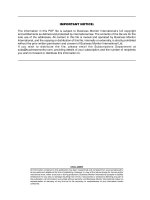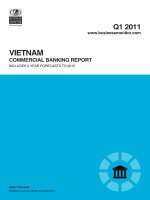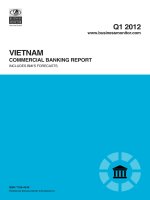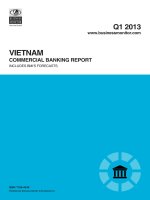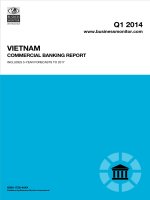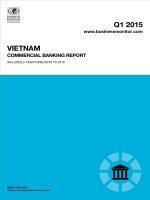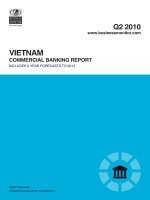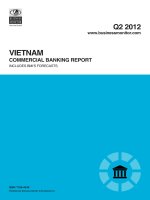Vietnam commercial banking report q2 2014
Bạn đang xem bản rút gọn của tài liệu. Xem và tải ngay bản đầy đủ của tài liệu tại đây (466.13 KB, 73 trang )
Q2 2014
www.businessmonitor.com
VIETNAM
COMMERCIAL BANKING REPORT
INCLUDES 5-YEAR FORECASTS TO 2018
ISSN 1758-454X
Published by:Business Monitor International
Vietnam Commercial Banking
Report Q2 2014
INCLUDES 5-YEAR FORECASTS TO 2018
Part of BMI’s Industry Report & Forecasts Series
Published by: Business Monitor International
Copy deadline: February 2014
Business Monitor International
Senator House
85 Queen Victoria Street
London
EC4V 4AB
United Kingdom
Tel: +44 (0) 20 7248 0468
Fax: +44 (0) 20 7248 0467
Email:
Web:
© 2014 Business Monitor International
All rights reserved.
All information contained in this publication is
copyrighted in the name of Business Monitor
International, and as such no part of this
publication may be reproduced, repackaged,
redistributed, resold in whole or in any part, or used
in any form or by any means graphic, electronic or
mechanical, including photocopying, recording,
taping, or by information storage or retrieval, or by
any other means, without the express written consent
of the publisher.
DISCLAIMER
All information contained in this publication has been researched and compiled from sources believed to be accurate and reliable at the time of
publishing. However, in view of the natural scope for human and/or mechanical error, either at source or during production, Business Monitor
International accepts no liability whatsoever for any loss or damage resulting from errors, inaccuracies or omissions affecting any part of the
publication. All information is provided without warranty, and Business Monitor International makes no representation of warranty of any kind as
to the accuracy or completeness of any information hereto contained.
CONTENTS
BMI Industry View 7
Table: Commercial Banking Sector Indicators 7
Table: Commercial Banking Sector Key Ratios, February 2013 7
Table: Annual Growth Rate Projections 2013-2018 (%) 7
Table: Ranking Out Of 71 Countries Reviewed In 2014 8
Table: Commercial Banking Sector Indicators, 2011-2018 8
SWOT 9
Commercial Banking 9
Political 10
Economic 11
Business Environment 12
Industry Forecast 13
Industry Risk Reward Ratings 18
Asia Commercial Banking Risk/Reward Ratings 18
Table: Asia Commercial Banking Risk/Reward Ratings 19
Market Overview 20
Asia Commercial Banking Outlook 20
Table: Banks' Bond Portfolios, 2012 20
Table: Comparison of Loan/Deposit & Loan/Asset & Loan/GDP ratios, 2014 20
Table: Comparison of Total Assets & Client Loans & Client Deposits (US$bn) 21
Table: Comparison of US$ Per Capita Deposits, 2014 22
Macroeconomic Forecast 22
Table: Vietnam - Economic Activity 26
Competitive Landscape 27
Market Structure 27
Protagonists 27
Table: Protagonists In Vietnam's Commercial Banking Sector 27
Definition Of The Commercial Banking Universe 27
List Of Banks 28
Table: Financial Institutions In Vietnam 28
Company Profile 30
Bank for Foreign Trade of Vietnam (Vietcombank) 30
Table: Stock Market Indicator 32
Table: Balance Sheet (VNDmn) 32
Table: Balance Sheet (US$mn) 33
Table: Key Ratios (%) 33
VietinBank 34
Table: Stock Market Indicators 36
Vietnam Commercial Banking Report Q2 2014
© Business Monitor International Page 4
Table: Balance Sheet (VNDmn) 36
Table: Balance Sheet (US$mn) 37
Table: Key Ratios (%) 37
Agribank 38
Table: Balance Sheet (VNDmn) 40
Table: Balance Sheet (US$mn) 40
Table: Key Ratios (%) 40
Asia Commercial Bank 41
Table: Stock Market Indicators 42
Table: Balance Sheet (VNDmn) 43
Table: Balance Sheet (US$mn) 43
Table: Key Ratios (%) 43
Eximbank 44
Table: Stock Market Indicators 46
Table: Balance Sheet (VNDmn) 46
Table: Balance Sheet (US$mn) 46
Table: Key Ratios (%) 47
Housing Development Commercial Joint Stock Bank (HDBank) 48
Sacombank 50
Table: Stock Market Indicators 52
Table: Balance Sheet (VNDmn) 52
Table: Balance Sheet (US$mn) 53
Table: Key Ratios (%) 53
Regional Overview 54
Asia Commercial Banking Overview 54
Global Industry Overview 59
Global Commercial Banking Outlook 59
Regional Outlooks 60
Demographic Forecast 64
Table: Vietnam's Population By Age Group, 1990-2020 ('000) 65
Table: Vietnam's Population By Age Group, 1990-2020 (% of total) 66
Table: Vietnam's Key Population Ratios, 1990-2020 67
Table: Vietnam's Rural And Urban Population, 1990-2020 67
Methodology 68
Industry Forecast Methodology 68
Sector Specific Methodology 69
Risk/Reward Ratings Methodology 70
Sector Specific Methodology 71
Table: Commercial Banking Risk/Reward Rating Indicators 71
Weighting 72
Table: Weighting Of Indicators 72
Vietnam Commercial Banking Report Q2 2014
© Business Monitor International Page 5
BMI Industry View
Table: Commercial Banking Sector Indicators
Date
Total
assets
Client
loans
Bond
portfolio Other
Liabilities
and capital Capital
Client
deposits Other
February 2012, VNDbn 3,388,150 2,772,420 278,421 337,309 3,388,150 560,003 2,483,817 344,330
February 2013, VNDbn 3,930,528 3,070,100 497,352 363,076 3,930,528 588,974 3,169,132 172,422
% change y-o-y 16.0% 10.7% 78.6% 7.6% 16.0% 5.2% 27.6% -49.9%
February 2012, US$bn 162.6 133.1 13.4 16.2 162.6 26.9 119.2 16.5
February 2013, US$bn 187.6 146.5 23.7 17.3 187.6 28.1 151.2 8.2
% change y-o-y 15.3% 10.1% 77.6% 7.0% 15.3% 4.6% 26.9% -50.2%
Source: BMI; Central banks; Regulators
Table: Commercial Banking Sector Key Ratios, February 2013
Loan/deposit ratio
Loan/asset ratio Loan/GDP ratio GDP Per Capita, US$ Deposits per capita, US$
96.88% 78.11% 92.69% 1,903.4 1,663.0
Falling Falling Falling n.a. n.a.
Source: BMI; Central banks; Regulators
Table: Annual Growth Rate Projections 2013-2018 (%)
Assets Loans Deposits
Annual Growth Rate 11 9 6
CAGR 12 10 7
Ranking 22 31 44
Source: BMI; Central banks; Regulators
Vietnam Commercial Banking Report Q2 2014
© Business Monitor International Page 7
Table: Ranking Out Of 71 Countries Reviewed In 2014
Loan/deposit ratio Loan/asset ratio Loan/GDP ratio
19 1 19
Local currency asset growth Local currency loan growth Local currency deposit growth
19 23 28
Source: BMI; Central banks; Regulators
Table: Commercial Banking Sector Indicators, 2011-2018
2011 2012 2013e 2014f 2015f 2016f 2017f 2018f
Total assets, VNDbn 3,437,893 3,917,557 4,466,015 5,091,257 5,753,121 6,443,495 7,152,280 7,939,030
Total assets, US$bn 163.4 188.0 212.7 247.6 283.0 320.6 359.4 403.0
Client loans, VNDbn 2,829,890 3,077,700 3,447,024 3,860,667 4,285,340 4,713,874 5,138,123 5,600,554
Client loans, US$bn 134.5 147.7 164.1 187.7 210.8 234.5 258.2 284.3
Client deposits, VNDbn 2,483,357 3,080,455 3,388,501 3,693,466 3,988,943 4,268,169 4,524,259 4,795,715
Client deposits, US$bn 118.1 147.8 161.4 179.6 196.2 212.3 227.3 243.4
e/f = estimate/forecast. Source: BMI; Central banks; Regulators
Vietnam Commercial Banking Report Q2 2014
© Business Monitor International Page 8
SWOT
Commercial Banking
Vietnam Commercial Banking SWOT
Strengths
■
Untapped market with potential for increased participation of foreign banks.
■
Large population with a high savings rate and potential for income growth.
■
The Vietnamese government aims to speed up the process of privatising state-owned
banks, which will help modernise the industry.
■
State-owned banks will play a lesser role going forward, and the risks associated with
state-directed lending will decrease over time.
Weaknesses
■
Domestic banks continue to lag behind their foreign peers in terms of financial
strength and the technological curve.
■
Accounting standards lag far behind international standards and the lack of
transparency entails significant risks for foreign investors.
■
Small banks have an overwhelming exposure to real estate and individual loans,
resulting in highly skewed and risky loan portfolios.
Opportunities
■
The population is still underbanked, with significant potential for adopting cash-free
payment systems and new mobile banking technologies.
■
Rising income levels and deepening capital markets could give rise to opportunities in
more sophisticated financial products and growth for the local asset management
industry.
Threats
■
Track record of macroeconomic instability threatens the credibility of the government
and could potentially drive economic policy away from further liberalisation.
■
The high level of government debt risks triggering a fiscal crisis, undermining
confidence in the banking sector.
Vietnam Commercial Banking Report Q2 2014
© Business Monitor International Page 9
Political
SWOT Analysis
Strengths
■
The Communist Party of Vietnam remains committed to market-oriented reforms and
we do not expect major shifts in policy direction over the next five years. The one-
party system is generally conducive to short-term political stability.
■
Relations with the US have witnessed a marked improvement, and Washington sees
Hanoi as a potential geopolitical ally in South East Asia.
Weaknesses
■
Corruption among government officials poses a major threat to the legitimacy of the
ruling Communist Party.
■
There is increasing (albeit still limited) public dissatisfaction with the leadership's tight
control over political dissent.
Opportunities
■
The government recognises the threat corruption poses to its legitimacy, and has
acted to clamp down on graft among party officials.
■
Vietnam has allowed legislators to become more vocal in criticising government
policies. This is opening up opportunities for more checks and balances within the
one-party system.
Threats
■
Macroeconomic instabilities continue to weigh on public acceptance of the one-party
system, and street demonstrations to protest economic conditions could develop into
a full-on challenge of undemocractic rule.
■
Although strong domestic control will ensure little change to Vietnam's political scene
in the next few years, over the longer term, the one-party-state will probably be
unsustainable.
■
Relations with China have deteriorated over recent years due to Beijing's more
assertive stance over disputed islands in the South China Sea and domestic criticism
of a large Chinese investment into a bauxite mining project in the central highlands,
which could potentially cause wide-scale environmental damage.
Vietnam Commercial Banking Report Q2 2014
© Business Monitor International Page 10
Economic
SWOT Analysis
Strengths
■
Vietnam has been one of the fastest-growing economies in Asia in recent years, with
GDP growth averaging 7.1% annually between 2000 and 2012.
■
The economic boom has lifted many Vietnamese out of poverty, with the official
poverty rate in the country falling from 58% in 1993 to 20.7% in 2012.
Weaknesses
■
Vietnam still suffers from substantial trade and fiscal deficits, leaving the economy
vulnerable to global economic uncertainties. The fiscal deficit is dominated by
substantial spending on social subsidies that could be difficult to withdraw.
■
The heavily-managed and weak currency reduces incentives to improve quality of
exports, and also keeps import costs high, contributing to inflationary pressures.
Opportunities
■
WTO membership and the upcoming ASEAN AEC in 2015 should give Vietnam
greater access to both foreign markets and capital, while making Vietnamese
enterprises stronger through increased competition.
■
The government will in spite of the current macroeconomic woes, continue to move
forward with market reforms, including privatisation of state-owned enterprises, and
liberalising the banking sector.
■
Urbanisation will continue to be a long-term growth driver. The UN forecasts the
urban population rising from 29% of the population to more than 50% by the early
2040s.
Threats
■
Inflation and deficit concerns have caused some investors to re-assess their hitherto
upbeat view of Vietnam. If the government focuses too much on stimulating growth
and fails to root out inflationary pressure, it risks prolonging macroeconomic
instability, which could lead to a potential crisis.
■
Prolonged macroeconomic instability could prompt the authorities to put reforms on
hold as they struggle to stabilise the economy.
Vietnam Commercial Banking Report Q2 2014
© Business Monitor International Page 11
Business Environment
SWOT Analysis
Strengths
■
Vietnam has a large, skilled and low-cost workforce, which has made the country
attractive to foreign investors.
■
Vietnam's location - its proximity to China and South East Asia, and its good sea links
- makes it a good base for foreign companies to export to the rest of Asia, and
beyond.
Weaknesses
■
Vietnam's infrastructure is still weak. Roads, railways and ports are inadequate to
cope with the country's economic growth and links with the outside world.
■
Vietnam remains one of the world's most corrupt countries. According to
Transparency International's 2012 Corruption Perceptions Index, Vietnam ranks 123
out of 176 countries.
Opportunities
■
Vietnam is increasingly attracting investment from key Asian economies, such as
Japan, South Korea and Taiwan. This offers the possibility of the transfer of high-tech
skills and know-how.
■
Vietnam is pressing ahead with the privatisation of state-owned enterprises and the
liberalisation of the banking sector. This should offer foreign investors new entry
points.
Threats
■
Ongoing trade disputes with the US, and the general threat of American
protectionism, which will remain a concern.
■
Labour unrest remains a lingering threat. A failure by the authorities to boost skills
levels could leave Vietnam a second-rate economy for an indefinite period.
Vietnam Commercial Banking Report Q2 2014
© Business Monitor International Page 12
Industry Forecast
BMI View: As the Vietnamese government looks to ramp up its agenda on privatising state-owned
enterprises (SOEs), our assessment suggests that the impact of these policies will be highly positive for the
economy. We believe that reducing the role of SOEs should help to stem the rise in bad debts across the
banking sector. Meanwhile, lifting foreign ownership limits on public and private companies should also
enhance market liquidity, spur financial market development, and boost foreign direct investment (FDI).
The Vietnamese government is set to ramp up efforts to privatise more state-owned enterprises (SOEs) and
raise foreign ownership limits and voting rights on publicly listed companies, a move that is being viewed
as a litmus test for investors betting on policymakers to push ahead with free-market reforms over the
coming years. Prime Minister Nguyen Tan Dung is expected to approve a legislative amendment over the
coming weeks that will allow foreigners to own up to 60% equity in publicly listed companies, compared to
the current limit of 49%. Foreign voting rights will also be raised for private companies to match the
existing foreign ownership limit of 49% (we expect limits on private companies to be raised further over the
coming years). Meanwhile, the Ministry of Finance (MoF) appears to be on track to meet its target of
restructuring more than 300 SOEs by 2015 - Ho Chi Minh City officials have unveiled plans to privatise 31
SOEs, and divest or potentially liquidate another 20 SOEs over the next two years.
Vietnam Commercial Banking Report Q2 2014
© Business Monitor International Page 13
A Shrinking Role For SOEs
Vietnam - Contribution To GDP By Ownership, pp
Source: BMI, General Statistics Office
Privatisation And Its Economic Impact
From our perspective, the economic benefits to be gained from speeding up privatisation of SOEs in
Vietnam are threefold. Firstly, we believe that SOEs are at the root of the country's macroeconomic
imbalances over the years. Vietnamese SOEs continue to dominate several industries such as shipping,
banking, and infrastructure, which combined account for an estimated 17% of employment and 50% of
corporate income tax revenue according to a recent report published by the International Monetary Fund
(IMF). Decades of preferential treatment, incentives, and subsidies from the government have not only
failed to foster companies that can compete effectively against foreign enterprises, but they have also
resulted in the rapid build-up of bad debt across the banking sector (SOEs are often given priority access to
loans under the government's directive). Thus, we believe that privatisation efforts could help to reduce the
risks of underperforming loans in the banking sector, which we believe is often the result of state-directed
lending.
Public spending on subsidies and wages for SOEs has also burdened the country's finances, causing the
government to run persistent budget deficits and failing to keep up with much-needed infrastructure
Vietnam Commercial Banking Report Q2 2014
© Business Monitor International Page 14
investment over the years. Consequently, we believe that renewed efforts to reduce the role of SOEs in the
economy should not only help to stem the rise in bad debts across the banking sector, but also free up
resources for investment in more productive areas such as infrastructure and technology.
Positive For Capital Market Development
Vietnam - Components Of Financial Market Development Index (2012-2013)
Source: BMI, World Economic Forum
Lifting Ownership Limits Could Enhance Market Liquidity
Secondly, we believe that foreign ownership limits on both private and publicly listed companies in
Vietnam could stifle the development of its financial markets. Foreign investment funds are reportedly
facing growing difficulties in managing their portfolios (especially with regards to investing more funds in
large-cap stocks) as most of the 30 largest companies listed on the local bourse have already reached (or are
near) their foreign ownership limits. Thus, raising these limits should have a positive impact in terms of
enhancing liquidity in the stock market. We believe that increased foreign participation in the local bourse
should also help to spur the development of a derivatives market, which is crucial in attracting large
institutional investors (who often need to hedge against various foreign exchange and market risks). We
Vietnam Commercial Banking Report Q2 2014
© Business Monitor International Page 15
also view this as a potential source of revenue for Vietnamese commercial banks that are looking to expand
into providing investment banking and other financial market services.
Booming Provinces
Vietnam - Foreign Direct Investment By Province (2012), US$bn
Source: BMI, General Statistics Office
Lastly, we believe that privatisation efforts by the Vietnamese government will play a major role in helping
to drive foreign direct investment (FDI) into the country. Multi-national companies (MNCs) are investing
heavily in the government's push for more free-market reforms over the coming years, which are likely to
open up SOE-dominated industries to foreign competition. Indeed, we expect private sector investment
(largely driven by FDI inflows) to play a major role in driving Vietnam's long-term economic growth. We
forecast real GDP growth to average 6.2% over the coming decade. Commercial banks are likely to benefit
significantly from the expansion of banking services to meet the specific needs of foreign companies.
Vietnam Commercial Banking Report Q2 2014
© Business Monitor International Page 16
Private Sector Investment To Lead The Way
Vietnam - Real GDP Growth, % (LHS) & GFCF, % of GDP (RHS)
Source: BMI, General Statistics Office
Deeper Reforms Needed To Improve Accounting Standards And Transparency
Overall, we are optimistic that these structural reforms will help to strengthen the country's macroeconomic
fundamentals and competitiveness going forward. However, government efforts in improving corporate
governance, accounting standards, and transparency, remain inadequate in our view. We caution that the
lack of progress in this area could potentially undermine the government's agenda on privatising SOEs, as
the risk of investing in local companies (hidden debt, inaccurate valuation of assets, lack of timely
accounting information) may prove to be uncomfortable for foreign investors with a lower risk mandate for
their portfolios. On a more positive note, the Vietnamese policymakers are fully aware of these weaknesses,
and we see ample scope for the government to introduce reforms on this front over the coming years.
Vietnam Commercial Banking Report Q2 2014
© Business Monitor International Page 17
Industry Risk Reward Ratings
Asia Commercial Banking Risk/Reward Ratings
Commercial Banking Risk/Reward Rating Methodology
Since Q108, we have described numerically the banking business environment for each of the countries
analysed by BMI. We do this through our Commercial Banking Industry Risk/Reward Rating (IRR), a
measure that ensures we capture the latest quantitative information available. It also ensures consistency
across all countries. Like all of BMI's Industry Risk/Reward Ratings, its takes into account the Rewards on
offer within the banking sector in a given country, but also the Risks to investors being able to realise those
opportunities. The overall Rating is weighted 70% towards Rewards and 30% towards Risks.
Within the Rewards category, we look at factors that are specific to the banking industry (accounting for
60% of the score within this category), and elements that relate to that country in general (accounting for
40% of the weighting). These include, but are not limited to, total assets, asset and loan growth, GDP and
taxation. Likewise on the Risks side, we look at industry-specific Risks (weighted 40% of the Risks total)
and country-specific Risks (weighted 60%). These include, but are not limited to, the regulatory framework
and environment, the competitive environment, financial risk, legal risk and policy continuity.
In general three aspects need to be borne in mind when interpreting the IRRs. The first is that the Industry
Rewards element is the most heavily weighted of the four elements, accounting for 42% (60% of 70%) of
the overall Rating. Second, if the Industry Rewards score is significantly higher than the Country Rewards
score, within the Rewards category, it usually implies that the banking sector is (very) large and/or
developed relative to the general wealth, stability and financial infrastructure in the country. Conversely, if
the industry score is significantly lower, it usually means that the banking sector is small and/or
underdeveloped relative to the general wealth, stability and financial infrastructure in the country. Third,
within the Risks category, the industry-specific elements (i.e. how regulations affect the development of the
sector, how regulations affect competition within it, and Moody's Investor Services' ratings for local
currency deposits) can be markedly different from BMI's long-term Country Risk rating for a given market.
Vietnam Commercial Banking Report Q2 2014
© Business Monitor International Page 18
Table: Asia Commercial Banking Risk/Reward Ratings
Limits of Potential Returns Risks to Potential Returns Overall
Market Structure Country Structure Market Risks Country Risks Rating Ranking
Bangladesh 56.7 45.0 43.3 44.0 49.5 53
China 93.3 57.5 63.3 74.0 76.2 14
Hong Kong 80.0 95.0 73.3 78.0 83.0 6
India 83.3 57.5 60.0 54.0 68.0 30
Indonesia 76.7 65.0 80.0 52.0 69.4 26
Japan 46.7 75.0 66.7 80.0 63.0 34
Malaysia 73.3 80.0 83.3 80.0 77.6 10
Pakistan 50.0 50.0 53.3 44.0 49.3 54
Philippines 53.3 62.5 60.0 58.0 57.5 40
Singapore 66.7 95.0 96.7 90.0 82.4 7
Sri Lanka 33.3 55.0 33.3 46.0 41.7 61
South Korea 76.7 85.0 83.3 76.0 79.7 9
Taiwan 76.7 72.5 86.7 76.0 76.6 12
Thailand 66.7 67.5 86.7 74.0 70.6 23
Vietnam 60.0 57.5 36.7 54.0 55.4 43
United States 93.3 85.0 100.0 82.0 89.8 1
Scores out of 100, with 100 the highest. Source: BMI
Vietnam Commercial Banking Report Q2 2014
© Business Monitor International Page 19
Market Overview
Asia Commercial Banking Outlook
Table: Banks' Bond Portfolios, 2012
Bond Portfolio, US$bn Bond as % total assets Year-on-year growth %
Bangladesh 20.0 22.5 13.9
China 1,873.0 8.7 17.5
Hong Kong 379.3 19.8 8.1
India 352.5 25.8 14.4
Indonesia* 17.3 4.3 17.7
Japan 3,123.6 30.7 3.4
Malaysia 87.4 14.5 24.3
Pakistan 41.5 42.9 33.7
Philippines 42.8 24.4 13.1
Singapore 91.5 12.3 12.6
Sri Lanka 5.1 17.3 25.5
South Korea 295.0 16.7 0.4
Taiwan 115.2 9.0 12.6
Thailand 82.1 17.0 21.4
Vietnam 20.4 10.9 64.4
United States 533.5 4.1 18.4
Source: Central banks, regulators, BMI. *Only 2011 data available
Table: Comparison of Loan/Deposit & Loan/Asset & Loan/GDP ratios, 2014
Loan/Deposit
ratio % Rank Trend
Loan/Asset
ratio % Rank Trend
Loan/GDP
ratio % Rank Trend
Bangladesh 89.4 38 Falling 67.1 13 Falling 55.2 44 Rising
China 70.0 63 Falling 52.3 44 Rising 121.1 11 Falling
Hong Kong 68.4 65 Rising 38.2 65 Rising 279.6 2 Rising
India 78.7 50 Falling 67.0 14 Falling 60.3 37 Rising
Indonesia 78.4 52 Falling 61.4 29 Falling 34.2 55 Falling
Japan 69.5 64 Falling 47.8 56 Falling 89.4 20 Falling
Malaysia 78.6 51 Falling 59.2 35 Falling 124.0 10 Rising
Vietnam Commercial Banking Report Q2 2014
© Business Monitor International Page 20
Comparison of Loan/Deposit & Loan/Asset & Loan/GDP ratios, 2014 - Continued
Loan/Deposit
ratio % Rank Trend
Loan/Asset
ratio % Rank Trend
Loan/GDP
ratio % Rank Trend
Pakistan 62.3 68 Rising 41.3 63 Falling 21.1 65 Rising
Philippines 77.7 53 Rising 55.0 41 Rising 36.1 54 Rising
Singapore 106.2 17 Rising 64.7 21 Rising 166.7 6 Rising
Sri Lanka 85.2 44 Rising 61.4 30 Falling 32.8 57 Rising
South Korea 112.0 11 Falling 71.4 7 Falling 105.9 13 Falling
Taiwan 81.4 47 Rising 64.1 23 Rising 170.3 5 Rising
Thailand 98.1 29 Falling 66.7 16 Rising 85.0 23 Falling
Vietnam 104.5 19 Rising 75.8 1 Falling 94.4 17 Falling
United States 103.2 20 Rising 72.6 6 Rising 60.3 38 Rising
Source: Central banks, regulators, BMI
Table: Comparison of Total Assets & Client Loans & Client Deposits (US$bn)
2014 2013
Total Assets Client Loans Client Deposits Total Assets Client Loans Client Deposits
Bangladesh 125.8 84.4 94.4 107.1 71.8 79.4
China 23,321.8 12,194.2 17,415.4 22,717.9 11,654.4 16,488.9
Hong Kong 2,189.3 836.0 1,222.4 2,046.1 774.1 1,142.4
India 1,879.7 1,259.6 1,601.3 1,500.1 1,005.2 1,256.6
Indonesia 507.1 311.2 397.1 437.2 273.1 328.0
Japan 9,236.9 4,410.7 6,348.6 9,055.7 4,345.6 6,224.2
Malaysia 751.8 444.8 565.6 666.2 395.9 501.2
Pakistan 122.1 50.4 80.9 107.4 44.3 70.1
Philippines 199.8 110.0 141.6 179.8 95.9 128.0
Singapore 821.4 531.5 500.6 778.4 463.2 450.4
Sri Lanka 39.9 24.5 28.8 33.8 20.7 24.7
South Korea 1,868.0 1,332.9 1,189.9 1,755.6 1,252.7 1,099.4
Taiwan 1,430.3 917.4 1,126.9 1,327.9 830.1 1,046.2
Thailand 535.6 357.2 364.3 497.2 330.0 336.5
Vietnam 247.6 187.7 179.6 212.7 164.1 161.4
Vietnam Commercial Banking Report Q2 2014
© Business Monitor International Page 21
Comparison of Total Assets & Client Loans & Client Deposits (US$bn) - Continued
2014 2013
United States 15,001.6 10,897.2 10,558.9 14,020.2 10,136.9 9,868.2
Source: Central banks, regulators, BMI
Table: Comparison of US$ Per Capita Deposits, 2014
GDP Per Capita
Client Deposits, per
capita
Rich 20% Client
Deposits, per capita
Poor 80% Client
Deposits, per capita
Bangladesh 964 596 2,383 149
China 7,269 12,495 49,980 3,124
Hong Kong 41,191 168,385 673,540 42,096
India 1,607 1,263 5,054 316
Indonesia 3,572 1,571 6,284 393
Japan 38,864 49,989 199,957 12,497
Malaysia 11,779 18,736 74,942 4,684
Pakistan 1,308 437 1,748 109
Philippines 3,011 1,414 5,657 354
Singapore 57,799 90,745 362,980 22,686
Sri Lanka 3,491 1,341 5,363 335
South Korea 25,420 24,033 96,134 6,008
Taiwan 22,375 48,099 192,395 12,025
Thailand 6,174 5,419 21,675 1,355
Vietnam 2,148 1,941 7,762 485
United States 56,067 32,732 130,930 8,183
Source: Central banks, regulators, BMI
Macroeconomic Forecast
BMI View: Although we expect the Vietnamese economy to record yet another quarter of sub-par growth in
Q413, we are beginning to see potential for upside surprises to domestic demand over the coming quarters.
Recent data on foreign direct investment inflows, remittances, passenger car sales, and property market
launches, suggests to us that domestic demand is on a nascent recovery, setting the stage for stronger 2014
growth.
Vietnam Commercial Banking Report Q2 2014
© Business Monitor International Page 22
The general consensus is expecting the Vietnamese economy to suffer yet another quarter of sub-par growth
mainly due to subdued external demand and the lack of progress on banking sector reforms. This is closely
in line with our view that real GDP growth will come in at just 5.3% in 2013, a slight improvement from
5.2% in 2012. Looking ahead to 2014, however, evidence of improving macroeconomic fundamentals in
Vietnam (especially with regards to the outlook for domestic demand) suggests to us the balance of risks to
our growth forecast of 6.0% is gradually tilting towards the upside.
Robust Remittances Could Boost Domestic Demand
Vietnam - Unrequited Transfers, US$mn
Source: BMI, Asian Development Bank
Remittances: According to estimates published by the World Bank, the Vietnamese economy is on track to
record a bumper year for remittance inflows. The country is expected to receive US$10.6bn in remittances
from Vietnamese citizens working abroad, a robust 6.5% increase from 2012. Crucially, we believe that
remittance inflows will remain strong over the coming quarters as macroeconomic conditions in Vietnam
continue to improve. Growing confidence in the stability of the Vietnamese dong should also help to
encourage Vietnamese workers abroad, to a certain extent, to remit a larger share of their earnings back
home. We believe that this will help to boost domestic demand while providing support for the currency.
Vietnam Commercial Banking Report Q2 2014
© Business Monitor International Page 23
Foreign Direct Investment: Total foreign direct investment (FDI) inflows are also set to surpass the
government's full-year target of US$13bn, after data released by the Ministry of Planning and Investment
showed that inflows surged by 19.5% year-on-year (y-o-y) growth over the first eight months of the year.
The strong reading chimes with our view that the country's solid long-term growth story should continue to
attract foreign investors over the coming years.
Automobile Sales: We are witnessing signs of a robust recovery in automobile sales, a sign that pent-up
domestic demand is beginning to rebound. According to the Vietnam Automobile Manufacturers
Association (VAMA), September vehicle sales of its members surged by 20.6% year-on-year (y-o-y),
exceeding our already bullish forecast of 12.5% for the year (see 'Bullish On CV Sales In The Medium To
Long Term', October 14 2013).
Developers Eyeing Property Market Rebound
Vietnam - Real Estate Index
Source: BMI, Bloomberg
Property Market: Meanwhile, we see increasing evidence that the Vietnamese property market may have
bottomed out (see 'Early Signs Of A Recovery, But No Property Market Boom In Sight', August 14 2013).
According to a quarterly report published by real estate agency CBRE Vietnam, the number of new
Vietnam Commercial Banking Report Q2 2014
© Business Monitor International Page 24
launches surged by 12% y-o-y in Q313. Anecdotal evidence from the local media suggests to us that
demand for real estate following the sharp decline in prices since 2011 may be recovering. To be sure, we
maintain our view that we are unlikely to see a property market boom given the healthy pipeline of new
units that will come online in 2014. Nonetheless, we acknowledge that consumer confidence is recovering
and we could potentially see some upside surprises to domestic demand in 2014.
Expenditure Breakdown
Private Consumption: We expect private consumption to grow at a relatively resilient pace of 5.0% in
2014. However, we note that the risk of further bankruptcies among SMEs could potentially lead to
widespread job losses, especially in export-driven sectors. Uncertainties over the outlook for employment
could, in turn, prompt households to cut back on spending.
Gross Fixed Capital Formation: We foresee a pickup in private sector investment growth in 2014, partly
led by increased foreign direct investment inflows. We believe lending rates will gradually ease over the
coming months as the effect of recent rate cuts by the SBV begins to kick in. We are also seeing evidence
that credit conditions are improving. Accordingly, we expect gross fixed capital formation growth to
accelerate slightly from 4.1% in 2013 to 4.8% in 2014.
Public Spending: We expect total public spending to remain relatively resilient in 2014, expanding at a
respectable pace of 6.1%. However, there is limited room for the government to increase spending further
owing to concerns over the need to finance a potential bailout of ailing state-owned commercial banks.
Net Exports: Net exports remain the biggest downside risk to our outlook for the Vietnamese economy,
although we expect external demand to pick up in 2014. Vietnam's trade account has fallen back into
deficits in recent months, but we see the case for a substantial pickup in external demand on the back of a
rebound in regional growth over the coming quarters. Accordingly, we still expect exports to expand at a
moderate pace of 5.9% in 2014.
Vietnam Commercial Banking Report Q2 2014
© Business Monitor International Page 25
